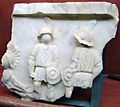Amphitheatre of Mérida facts for kids
|
Anfiteatro de Mérida
|
|
 |
|
| Location | Mérida (Badajoz), Spain |
|---|---|
| Coordinates | 38°54′58.3″N 6°20′15.8″W / 38.916194°N 6.337722°W |
| Type | Roman amphitheatre |
| Official name: Amphitheatre | |
| Type: | Cultural |
| Criteria: | iii, iv |
| Designated: | 1993 (17th session) |
| Part of: | "Roman Theatre, Amphitheatre, the Amphitheatre House" part of the Archaeological Ensemble of Mérida |
| Reference #: | 664-005 |
| Region: | Europe and North America |
| Official name: Anfiteatro Romano | |
| Type: | Non-movable |
| Criteria: | Monument |
| Designated: | 13 December 1912 |
| Reference #: | RI-51-0000108 |
The Amphitheatre of Mérida is an ancient Roman amphitheatre located in Mérida, Spain. This amazing building was finished in 8 BC. It was a place where people watched exciting shows. These shows included gladiator fights and battles between people and wild animals.
The city of Mérida was once called Emerita Augusta. It was founded in 25 BC by the Roman Emperor Augustus. He created the city for soldiers who had finished their time in the Roman army. These soldiers were called emeritus, meaning they were honorably discharged.
The amphitheatre was built next to the Roman Theatre. Both are now part of the Archaeological Ensemble of Mérida. This whole area is one of the biggest and most important ancient sites in Spain. In 1993, UNESCO declared it a World Heritage Site. This means it's a very special place that needs to be protected.
History of the Amphitheatre
The Amphitheatre of Mérida opened its doors in 8 BC. It was built for public entertainment. People came to watch thrilling gladiator fights. They also saw exciting shows where men fought wild animals. Sometimes, animals fought each other too. These animal fights were called venationes.
-
A stone carving of gladiators from the Amphitheatre.
Design and Features
The Amphitheatre of Mérida has an oval shape. It is about 126 meters long and 102 meters wide. The central area, called the arena, was 64 meters long and 44 meters wide. The arena was covered with sand.
In the middle of the arena, there was a hidden pit called a fossa bestiaria. This pit was covered with wood and sand. It was used to hold wild animals before they were let out into the arena for the shows.
The amphitheatre had seating areas for about 15,000 people. These seats were divided into different sections. There were stairs and hallways that helped people move around inside. The lowest seats were for important local leaders. Other rows were for the general public. There were also special viewing boxes on either side of the arena. Under these boxes, there was an important stone carving. This carving helped historians figure out when the amphitheatre was built.
See also
 In Spanish: Anfiteatro de Mérida para niños
In Spanish: Anfiteatro de Mérida para niños




